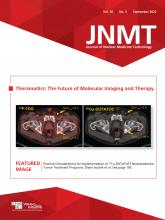SUMMARY
223Ra-dichloride (Xofigo; Bayer) is an α-emitting radioactive agent used to treat symptomatic bone metastases in patients with castration-resistant prostate cancer in the absence of visceral metastases (1). It functions as a calcium analog and causes double-strand DNA breaks in tissue, resulting in the death of tumor cells (2).
CLINICAL INDICATIONS (1)
223Ra-dichloride is indicated for treatment of symptomatic bone metastasis in patients who have castration-resistant prostate cancer with no known visceral metastasis.
PATIENT SELECTION (1)
To be eligible for treatment, patients must have all of the following:
^ Castration-resistant prostate cancer.
^ Symptomatic bone metastasis.
^ No known visceral metastasis.
Once deemed eligible, patients must meet the following hematologic criteria before their first treatment:
^ Absolute neutrophil count ≥ 1.5×109/L.
^ Platelet count ≥ 100×109/L.
^ Hemoglobin ≥ 10 g/dL.
For all subsequent treatments, the patient’s hematologic values must be as follows:
^ Absolute neutrophil count ≥ 1×109/L.
^ Platelet count ≥ 50×109/L.
CONTRAINDICATIONS (1)
There are no contraindications to use of 223Ra-dichloride.
TREATMENT PLAN (1)
55 kBq (1.49 μCi) of 223Ra-dichloride is given per kilogram of body weight every 4 weeks for a total of 6 treatments.
^ Volume (mL) to inject, in kBq/kg:

^ Volume (mL) to inject, in μCi/kg:

Prescribing information provides up-to-date dose calculations.
PATIENT PREPARATION/EDUCATION (1)
The most common side effects of 223Ra-dichloride are myelosuppression, nausea, vomiting, diarrhea, and peripheral edema.
Patients should be given information on radiation safety precautions before administration of 223Ra-dichloride to reduce exposure to others. For example:
^ Flushing the toilet multiple times after each use.
^ Washing clothing soiled with 223Ra-dichloride, feces, or urine quickly after they become contaminated. This should be done separately from other clothing or items.
^ Using gloves and frequently washing the hands when anyone handles patient clothing and bodily fluids.
^ Using condoms for the duration of treatments and 6 months afterward. Partners of reproductive capability should also use effective forms of contraception for the length of treatment and 6 months afterward.
Other than the sexual activity restrictions, the prescribing information does not specify any distance or length of time that patients must restrict contact with household members.
TREATMENT INSTRUCTIONS
The patient’s blood counts must be obtained and confirmed to be in the desired range before treatment (1). The decision to delay treatment, reduce the dose given, or make any other alterations to the standard treatment plan is ultimately a clinical decision (2).
A 55-kBq (1.49 μCi) dose of 223Ra-dichloride per kilogram of body weight is administered intravenously over 1 min (1). For dose accuracy, the patient’s body weight should be measured on the day of treatment.
Before and after administration of 223Ra-dichloride, the intravenous line should be flushed with isotonic saline (1).
Roughly 1% of the emissions from 223Ra-dichloride are γ-radiation, which allows surfaces and personnel to be surveyed for contamination with standard instruments (1).
THERAPEUTIC DOSE CALCULATIONS (1)
The therapeutic dose is 55 kBq (1.49 μCi) per kilogram of body weight.
Discontinuation of treatment should be considered if the patient’s laboratory values do not recover within 6–8 weeks of the last treatment received.
WARNINGS/PRECAUTIONS
Bone marrow suppression is a possible side effect of 223Ra-dichloride, and patients should be closely monitored for signs of bone marrow failure (1). Patients should be instructed to inform their care team if they have any signs of bleeding or symptoms of infection.
223Ra-dichloride is not recommended in combination with abiraterone acetate plus prednisone or prednisolone as it increases the risk of fractures and mortality (1).
223Ra-dichloride has the potential to cause fetal harm. Patients should use condoms, and patients’ partners of reproductive capability should use effective contraception for the length of treatment and 6 months afterward (1).
Receiving docetaxel or any other form of systemic therapy except for androgen deprivation therapy while undergoing treatment with 223Ra-dichloride is not recommended. 223Ra-dichloride is also not intended to be used in conjunction with chemotherapy, as this increases the risk and burden of myelosuppression (3).
Dose, Administration Route, and Infusion Duration for 223Ra-Dichloride (1)









